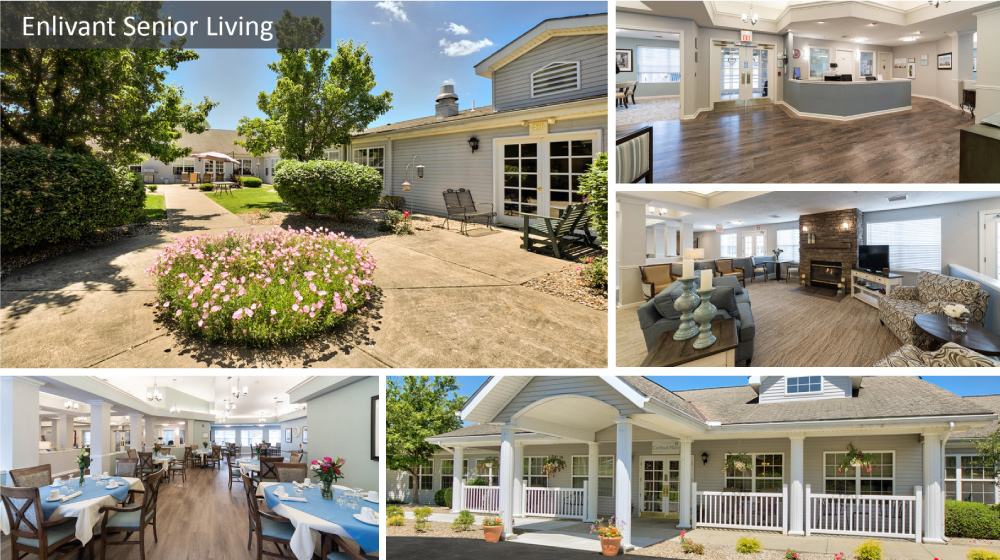Earlier this year Enlivant became the first senior living operator to earn the WELL Health-Safety Rating for its entire portfolio of 215 communities. Sunrise Senior Living, meanwhile, committed to seeking WELL ratings for its portfolio of 280 communities, or approximately 22 million feet of real estate. These moves by some of the industry’s biggest players reflect an essential takeaway from the last two years: to live healthy lives, we need healthy spaces.
That lesson came with tremendous costs, many of which the industry is still bearing: talent shortages, low retention rates, increasing service costs, and stagnant reimbursement rates. “The Great Resignation, we know, has hit senior living hard,” said Rachel Hodgdon, CEO of the International WELL Building Institute, at the Senior Living Innovation Forum in Napa, California. “Many of your staff have suffered acute trauma. They're tired, they're stressed, they're anxious and they're burnt out.”
Hodgdon believes the WELL Building Standard can help senior living providers overcome these challenges, and like the Standard itself, her belief is well grounded in evidence. In her presentation, she explained WELL’s approach to certification, its benefits for the workplace and public health alike, and senior living communities have thrived after earning their own WELL designations.
A Flexible Approach
As Hodgdon explained, WELL certifications come in many forms, enabling senior living providers to work towards the designation that suits them best. That might mean the full WELL certification, one encompassing all ten categories of health and well-being under the WELL umbrella: mental health and well-being, community, movement, water quality, air quality, light, thermal comfort, nourishment, sound, and healthy materials. Or it might mean a more tailored designation based on an organization’s specific goals.
“WELL is extremely flexible, so you can choose the features that are going to matter most to you,” Hodgdon said. “Do you want to reopen safely and with confidence, reduce employee stress and burnout, foster employee engagement and retention? WELL can help you to create a roadmap for accomplishing all of those objectives.”
The WELL building standard might sound similar to the LEED rating system, but Hodgdon stressed that it serves a much different purpose. “While LEED has a focus on planetary health, first and foremost, WELL has a focus on human health,” she said. “We believe that that's where you're going to see the greatest returns because the average business spends about 90% of their annual operating expenses on their people. And when you prioritize the health of your people, you can demonstrate tremendous leadership and attract and retain the best talent.”
Indeed, the IWBI’s data clearly illustrates this relationship between health and productivity. After the American Society of Interior Design achieved a WELL platinum designation, it saw absenteeism plummet by 19% in a single year. After CBRE earned WELL certifications for its workspaces in Toronto and Vancouver, its hiring rate doubled while turnover decreased by nearly a third. And when Landsec earned a WELL Silver certification for its London office, productivity spiked an impressive 30 percent.
Of course, the health benefits speak for themselves as well. “At IWBI, we fundamentally believe that buildings themselves can serve as protective and preventative care,” Hodgdon said, citing the role of the workplace in the broader fabric of social determinants of health.
“Your physical and social environment, where you sit and who you sit next to, has a greater bearing on your health and wellbeing than your access to healthcare, your lifestyle and behaviors and genetics combined,” she said. “What that means is that physical and social environments can have a profound impact on the state of health. And it means that these factors are largely within your control, the ones that will have the greatest yield.”
Healthier Spaces, Happier Occupants
For senior living communities that take control of their physical and social environments, the results are undeniable. When Menno Haven Rehabilitation Center in Pennsylvania worked towards its WELL certification—eventually earning a Gold designation in 2019—it incorporated more daylight into the facility, raised its ceilings and added elements of biophilia to create a more expansive and natural feeling, improved its air and water filtration systems, all to rave reviews from residents and their families.
With the goal of providing “a person-centered experience,” Menno Haven even consolidated its food production into one space on the campus and optimized its distribution schedule, meaning it could offer dietary staff normal working hours—8am to 5pm. This allowed the community to recruit more talented staff, which in turn improved the quality of the food for residents. But it’s not just the big things that make a big difference. Simply adding a window in the kitchen gave Menno Haven’s culinary workers a more pleasant experience, improving not only recruitment but also retention.

As The Views in Marion, Iowa pursued its own WELL Gold designation, focusing on biophilic design and intuitive wayfinding, it found that a healthy building meant a happy community. The community’s owner and operator, Enlivant, made this discovery on a broader scale as it worked towards WELL ratings for its portfolio.
As its CFO Matt Vaccariello testified in one of Hodgdon’s slides, the factor most correlated with retention at its communities wasn’t wages, but culture. “Being transparent about who you are as an organization creates an environment where people who want to do that job and work for you; they stay,” he said.
At the same time, an emphasis on health and wellbeing creates a competitive advantage on the resident side as well. “We're not selling real estate,” Vaccariello said. “We’re selling trust that we will care for someone's mom, dad, grandmother, grandfather. The ability to say that we've tested that against other people's scorecards is worth a great deal to us.”
An Opportunity to Invest in Caregivers
In closing, Hodgdon turned to her own experience co-chairing the board of the Garrison Institute, a retreat in an old monastery overlooking the Hudson River in upstate New York. One of the retreat’s programs, “Caring for the Caregiver,” builds on the experiences of aid workers in communities riven by conflict and disaster to teach participants how to invest in the caregivers in their own communities.
“What the evidence shows is that if you invest in the caregivers themselves, if you give them the tools to cultivate their own resilience, to take care of their own mental health, that has a profound ripple effect across the entire community,” she concluded.
“That's what this moment in time represents for senior living… an opportunity to invest in the caregivers for a massive and profound impact on the organization, both its culture and its bottom line.”

Posted by
SLIF heads to Carlsbad!
The One of a Kind Retreat for Senior Housing Leaders.
May 31 - June 2, 2026 | Carlsbad, CA
Learn More









Comments